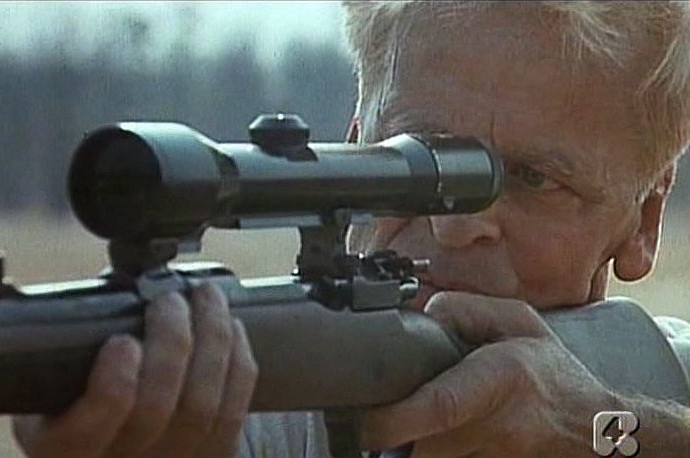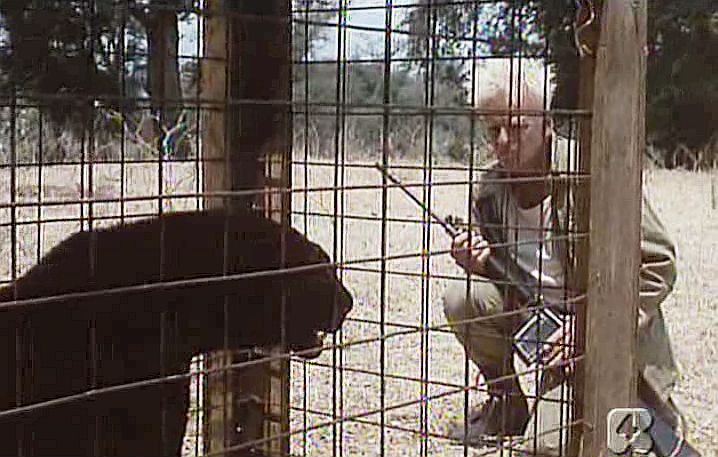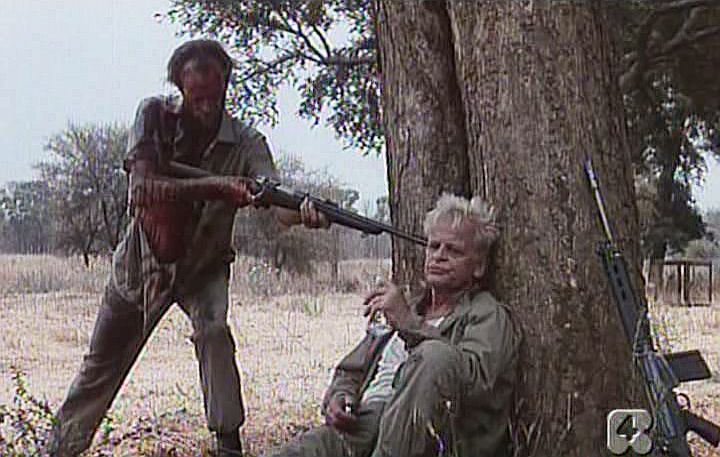Dir: Augusto Caminito
Star: Harvey Keitel, Klaus Kinski, Roberto Bisacco, Yorgo Voyagis
Well, this is a weird beast, and make no mistake about it. At least one place describes it as “Klaus Kinski’s last film,” which doesn’t seem right to me, since I always thought that title belonged to Paganini. This is what it goes on to say: I can’t vouch for the accuracy, and it’s on a members-only forum, so there’s no point linking, but would certainly explain some of the more bizarre aspects. “Kinski had an agreement for 4 movies with Carlo Alberto Alfieri and Caminito, including Paganini. But you know Kinski: after shooting the second one, his Paganini, he made a lot of trouble while shooting the third and then, after shooting the first part in Africa, left the set while in Alaska. Consequently the story was changed and Kinski dies after 40 minutes or so.” I’m not sure what four films they would be: aside from Paganini, there’s also Vampire in Venice and this one, but that’s only three, so we still seem to be missing one. Neither Alfieri nor Caminito have anything else on their filmographies around this time with Klaus. Maybe the contract never was completed, with Grandi Cacciatori (which translates as “Great Hunters”) being the third?
It certainly globe-trots, with the first chunk, as noted, in Africa, where Kinski plays Klaus Naginsky, a famous big-game hunter, whose life goes off the rails after his wife is attacked and killed by a black panther. He starts drinking heavily, and becomes obsessed with the animal in question, considering it “his”, to the extent that he reacts violently when another party attempts to capture the panther. The resulting gun-battle gets Naginsky sent to prison, but he is bailed out by Hermann (Bisacco), who has an offer: a hunting job on the other side of the world, in Alaska. There, Hermann’s brother, a film-maker, was killed while documenting the barbaric practices of the annual fur seal hunt, with the last seconds of footage testifying to the identity of the killer. Klaus is hired to wait on the pack ice, wait for the hunters to return, identify the perpetrator and deliver some Arctic justice. However, Klaus – Naginsky, but if the report above is true, Kinski as well! – vanishes without trace, and Herman has bring a replacement for the same task, Thomas (Keitel), who gets the same spiel and follows his predecessor onto the ice.
Things don’t go so well, though he does discover his predecessor, entombed in the ice, gazing up at him like a mammoth, looking slightly surprised. [Man, that would be a great idea for a SyFy original movie: Kinski Comes Alive, in which a deep-frozen KK is discovered in the German Alps, is thawed, and goes on a rampage through the modern film industry…] Worse is to follow, as Thomas’s first encounter with the hunters ends with him being clubbed on the side of the head, and left unconscious in the snow. Fortunately, he is found by one of the native inhabitants, who takes Thomas back to his igloo, and nurses the hunter of hunters back to health. While recuperating, he is shown the wreckage of a downed plane, left over from the end of World War II, and in it’s hold, preserved better than you’d expect due to the cold conditions, is a very large machine-gun. With the aid of some Eskimo urine (look, I’m not making this up!), Thomas gets the gun ship-shape, and in something with echoes of Django, heads of for another encounter with the hunters, intent on completing Hermann’s mission of vengeance.
In some ways, this is “Klaus Kinski vs. the Wilderness” – and, as usual, the wilderness comes out on top. I think it’s a shame he walked off the set, as there is definite potential shown in the early scenes. Naginsky’s relationship with the panther that killed his woman is a deliciously weird one. It’s a true love-hate deal, which sees the hunter incredibly possessive, prepared to shoot up anyone he perceives as a threat to the animal – yet it’s apparently only because he wants to be the one who kills it. I’m certainly tempted to read many kinds of psychological meanings into the film, given daughter Nastassja’s portrayal of a woman who turns into a black panther, earlier in the eighties. You could organize an entire convention of psychiatrists around an analysis of this movie, in that regard. However, it’s an angle that’s entirely dumped after Kinski is sent to prison, even before his transformation into a giant popsicle. I’m not sure why, and wonder how the film might have gone in a radically different direction, if not for the need to replace Kinski with Keitel.
Keitel isn’t bad; he rarely is. But in his second “overlap” with Kinski, after El caballero del dragón (which did at least have them share scenes, unlike this!), you sense Cacciatori is more of a case where he rolled up his sleeves and got down to some jobbing acting. The switch in focus from one character to another after the first third is extremely jarring, and they would have been far better off, simply junking the footage shot with Kinski and beginning the film all over again. I imagine it was purely a business decision, the production being unable to fund a return trip to Africa to reshoot all the footage there, with a different lead actor. If so, it didn’t pay off, as the film appears to have received little or no distribution at the time, and subsequently vanished into the black hole of lost rights for a quarter-century, until unexpectedly showing up on Italian TV, from where a fan-subbed version was generated, and can be found in several places, including YouTube. It’s certainly worth a look, though probably benefits from the viewer being forewarned regarding the… ah, difficult nature of its creation!


